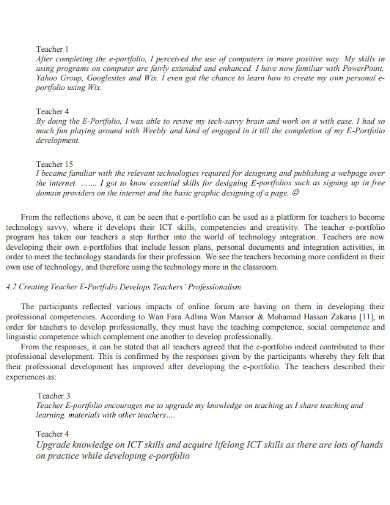
Creating a portfolio is an essential part of showcasing your work and skills. Whether you are a professional seeking new opportunities or a student reflecting on your achievements, a portfolio is a great way to present your best work. In this article, we will explore the definition of a portfolio, the differences between various types of portfolios, and how to create an effective portfolio introduction.
A portfolio is a collection of your work, which can include essays, projects, artwork, and more. It serves as a reflection of your skills, experience, and creativity. Portfolios can be used in a variety of settings, such as job applications, academic assignments, or teaching examples. They are a way to showcase your abilities, demonstrate your growth over time, and provide evidence of your accomplishments.
There are different types of portfolios, each with its own purpose and focus. Some portfolios are open-ended, allowing you to include a wide range of materials and showcase your versatility. Others may have specific requirements, such as a limited number of pages or a deadline for submission. Understanding these differences will help you tailor your portfolio to its intended audience and purpose.
The first step in creating a portfolio introduction is to clearly define your goals and objectives. What do you want to achieve with your portfolio? Are you looking to secure a job, apply for a scholarship, or showcase your progress as a student? Once you have a clear understanding of your purpose, you can begin to gather your best work and organize it in a way that highlights your strengths and accomplishments.
An effective portfolio introduction should capture the attention of the reader and provide a brief overview of the contents. It should address the purpose of your portfolio and present a compelling argument as to why your work should be considered. You can include a brief personal statement, highlighting your background, interests, and any relevant experiences. Additionally, you may want to include examples of your best work or provide a brief description of the activity or assignment that produced it.
1 Portfolio Essay Definition

A portfolio essay is a type of writing assignment that intends to showcase a student’s works, reflections, and achievements throughout a specific period of time. It is typically used by teachers to assess a student’s progress and growth, as well as their ability to critically reflect on their own work.
A portfolio essay usually consists of a collection of pages or materials that highlight the student’s best pieces of work from various assignments or projects. The portfolio essay often includes a brief introduction that addresses the purpose or theme of the portfolio, as well as a reflective essay that explains the student’s thought process and growth during the creation of the portfolio.
One thing to note is that portfolios are not limited to just written works. It may also include other forms of media such as artwork, presentations, videos, or any other creative activity that showcases the student’s skills and achievements.
Creating a portfolio essay requires time and effort. Students should plan their portfolios in advance and set deadlines for each part of the essay. By doing so, they can ensure that they have enough time to gather and organize their works, write the reflective essay, and edit the final draft. It is also important to seek guidance from teachers or peers who can provide feedback and help improve the portfolio.
Examples of portfolio essay topics could include: an analysis of the student’s growth in a specific subject or skill, the challenges and successes encountered during a particular project, or the student’s overall learning experience in a certain period of time.
In conclusion, a portfolio essay is a valuable tool in teaching and learning. It allows students to showcase their best works, reflect on their progress, and demonstrate their skills and achievements. Through open and creative writing, students can create meaningful and compelling portfolio essays that address the specific requirements and goals set by their teachers.
Activity: The First Draft of your ITMA Portfolio
Creating a portfolio is an important part of the ITMA program. It allows you to showcase your work, assignments, and reflections throughout the course. To start, you need to create the first draft of your portfolio.
Your first draft of the portfolio should include the following components:
| Component | Description |
|---|---|
| Introduction | Write an introductory essay that provides a definition of the ITMA portfolio and how it fits into your overall goals as a student and professional. |
| Examples of Work | Select some of your best assignments and works from the course to include in your portfolio. Make sure to choose examples that demonstrate your skills and achievements. |
| Reflection | Include a reflection on your learning experiences throughout the course. Address how the assignments and works in your portfolio have helped you grow as a student and professional. |
Take some time to gather all the materials and pages you want to include in your portfolio. Make sure to review the guidelines provided by your teacher or ITMA program to ensure you meet any specific requirements for the portfolio.
Once you have gathered all the necessary materials, start creating the first draft of your portfolio. You can use an online portfolio editor, such as Leonard, which is an open-source tool for creating digital portfolios. Leonard provides a user-friendly interface to help you arrange your portfolio pages and customize their appearance.
Remember, this is just a first draft, so don’t worry too much about the layout and design at this stage. The most important thing is to get all your work and reflections organized in one place. You can always refine and improve the design later.
Set a deadline for yourself to complete the first draft of your portfolio. This will help you stay on track and ensure you have enough time to review and make any necessary changes before submitting the final version.
By completing this activity, you will have taken the first step towards creating your ITMA portfolio. This portfolio will not only showcase your achievements but also serve as a valuable teaching tool for future students and an avenue for self-reflection and growth.









